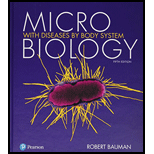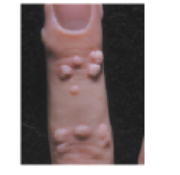
Microbiology with Diseases by Body System (5th Edition)
5th Edition
ISBN: 9780134477206
Author: Robert W. Bauman Ph.D.
Publisher: PEARSON
expand_more
expand_more
format_list_bulleted
Concept explainers
Textbook Question
Chapter 19, Problem 2CCS
A Child with Warts

Ten-year-old Rudy has several large warts on the fingers of his hands. They do not hurt, but their unsightly appearance causes him to shy away from people. He is afraid to shake hands or to play with other children, out of fear that he may transfer the warts to them. Initially, his mother tells him not to worry about them, but Rudy cannot help feeling self-conscious. Furthermore, Rudy fears that the warts may somehow spread on his own body. After consulting a physician, his mother decides to have the warts surgically removed.
- 1. Is it possible that Rudy’s warts will spread to other parts of his body?
- 2. Is it possible for someone else to “catch” Rudy’s warts by shaking his hand?
- 3. If Rudy’s warts disappear without t reatment, are they likely to return to the same sites on his hand?
- 4. Are the warts on Rudy’s finger likely to become cancerous?
- 5. Following surgical removal of the warts, is there a chance that Rudy will develop warts again?
Expert Solution & Answer
Want to see the full answer?
Check out a sample textbook solution
Students have asked these similar questions
rewrite:
Problem 1 (Mental Health): The survivor victim is dealing with acute stress and symptoms of a
post-traumatic stress disorder (PTSD) due to their traumatic experience during the January 2025 wildfire.
Goal 1: To alleviate the client's overall level, frequency, and intensity of
anxiety and PTSD symptoms so that daily functioning remains
unimpaired.
Objective 1: The client will learn and regularly use at least two anxieties
management techniques to reduce anxiety symptoms to less than three episodes per week.
Intervention 1: The therapist will provide psychoeducation about anxiety and
PTSD, including their symptoms and triggers. The therapist will also teach and assist the client in adopting relaxation techniques, such as deep breathing exercises and progressive muscle relaxation, to better manage anxiety and lessen PTSD symptoms.
O Macmillan Learning
You have 0.100 M solutions of acetic acid (pKa = 4.76) and sodium acetate. If you wanted to prepare 1.00 L of 0.100 M acetate
buffer of pH 4.00, how many milliliters of acetic acid and sodium acetate would you add?
acetic acid:
mL
sodium acetate:
mL
How does the cost of food affect the nutritional choices people make?
Chapter 19 Solutions
Microbiology with Diseases by Body System (5th Edition)
Ch. 19 - Prob. 1TMWCh. 19 - Prob. 2TMWCh. 19 - Buruli Ulcer Jacques liked living in the...Ch. 19 - A New Cause of Spots Fifty-two-year-old David has...Ch. 19 - Prob. 3TMWCh. 19 - A Painful Rash A mother brings her three-year-old...Ch. 19 - A Child with Warts Ten-year-old Rudy has several...Ch. 19 - Grandfathers Shingles The Davises were excited...Ch. 19 - Prob. 4TMWCh. 19 - Prob. 4CCS
Ch. 19 - Prob. 5TMWCh. 19 - Diagnosis in the Desert In the 1970s,...Ch. 19 - Prob. 6TMWCh. 19 - Prob. 3EDCSCh. 19 - The epidermis ____. a. has an intricate network of...Ch. 19 - Prob. 2MCCh. 19 - Prob. 3MCCh. 19 - Prob. 4MCCh. 19 - Prob. 5MCCh. 19 - Prob. 6MCCh. 19 - Prob. 7MCCh. 19 - Prob. 8MCCh. 19 - Prob. 9MCCh. 19 - Prob. 10MCCh. 19 - Prob. 11MCCh. 19 - Prob. 12MCCh. 19 - Prob. 13MCCh. 19 - Prob. 14MCCh. 19 - Prob. 15MCCh. 19 - Prob. 1MCh. 19 - Prob. 1FIBCh. 19 - Prob. 2FIBCh. 19 - Prob. 3FIBCh. 19 - Prob. 4FIBCh. 19 - Prob. 5FIBCh. 19 - Prob. 6FIBCh. 19 - Prob. 7FIBCh. 19 - Prob. 8FIBCh. 19 - Prob. 9FIBCh. 19 - Most pimples result from infection by ______ not...Ch. 19 - Prob. 1MTFCh. 19 - Prob. 2MTFCh. 19 - Prob. 3MTFCh. 19 - Prob. 4MTFCh. 19 - Prob. 5MTFCh. 19 - Prob. 1SACh. 19 - Prob. 2SACh. 19 - Considering that Pseudomonas aeruginosa and...Ch. 19 - Prob. 4SACh. 19 - Prob. 5SACh. 19 - Describe four enzymes produced by Staphylococcus,...Ch. 19 - Prob. 7SACh. 19 - Prob. 8SACh. 19 - Prob. 9SACh. 19 - Prob. 10SACh. 19 - Label each lesion seen in poxvirus infections.Ch. 19 - Prob. 2VICh. 19 - Prob. 3VICh. 19 - Prob. 1CTCh. 19 - Why is it more difficult to rid a community of a...Ch. 19 - Prob. 3CTCh. 19 - Prob. 4CTCh. 19 - Prob. 5CTCh. 19 - Most DNA viruses replicate within the nucleus of a...Ch. 19 - Prob. 7CTCh. 19 - Prob. 8CTCh. 19 - Prob. 9CTCh. 19 - Prob. 10CTCh. 19 - Prob. 11CTCh. 19 - Why do impetigo and erysipelas occur more commonly...Ch. 19 - Prob. 13CTCh. 19 - Prob. 14CTCh. 19 - Prob. 1CM
Knowledge Booster
Learn more about
Need a deep-dive on the concept behind this application? Look no further. Learn more about this topic, biology and related others by exploring similar questions and additional content below.Similar questions
- Biopharmaceutics and Pharmacokinetics:Two-Compartment Model Zero-Order Absorption Questions SHOW ALL WORK, including equation used, variables used and each step to your solution, report your regression lines and axes names (with units if appropriate) :Calculate a-q a) B1, b) B2, c) hybrid rate constant (1) d) hybrid rate constant (2) e) t1/2,dist f) t1/2,elim g) k10 h) k12 i) k21 j) initial concentration (C0) k) central compartment volume (V1) l) steady-state volume (Vss) m) clearance (CL) AUC (0→10 min) using trapezoidal rule n) AUC (20→30 min) using trapezoidal rule o) AUCtail (AUC360→∞) p) total AUC (using short cut method) q) volume from AUC (VAUC)arrow_forwardWhat are some external influences that keep people from making healthy eating decisions?arrow_forwardWhat type of structure(s) would you expect to see in peripheral membrane proteins? (mark all that apply) A. Amphipathic alpha helix (one side is hydrophilic and one side is hydrophobic) B. A hydrophobic beta barrel C. A hydrophobic alpha helix D. A chemical group attached to the protein that can anchor it to the membranearrow_forward
- Temporal flexibility (the ability to change over time) of actin structures within a cell is maintained by… A. The growth/shrinkage cycle B. Periodic catastrophe C. GTP hydrolysis D. Treadmilling E. None of the abovearrow_forwardDuring in vitro polymerization of actin and microtubule filaments from their subunits, what causes the initial delay in filament growth? A.Nucleation B.Reaching homeostasis C.Nucleotide exchange D.ATP or GTP hydrolysis E.Treadmillingarrow_forwardYou expect to find which of the following in the Microtubule Organizing Center (MTOC)...(mark all that apply) A. Gamma tubulin B. XMAP215 C. Centrioles D. Kinesin-13arrow_forward
- The actin-nucleating protein formin has flexible “arms” containing binding sites that help recruit subunits in order to enhance microfilament polymerization. What protein binds these sites? A.Thymosin B.Profilin C.Cofilin D.Actin E.Tropomodulinarrow_forwardWhile investigating an unidentified motor protein, you discover that it has two heads that bind to actin. Based on this information, you could confidently determine that it is NOT... (mark all that apply) A. A myosin I motor B. A dynein motor C. A myosin VI motor D. A kinesin motorarrow_forwardYou isolate the plasma membrane of cells and find that . . . A. it contains regions with different lipid compositions B. it has different lipid types on the outer and cytosolic leaflets of the membrane C. neither are possible D. A and B both occurarrow_forward
- You are studying the mobility of a transmembrane protein that contains extracellular domains, one transmembrane domain, and a large cytosolic domain. Under normal conditions, this protein is confined to a particular region of the membrane due to the cortical actin cytoskeletal network. Which of the following changes is most likely to increase mobility of this protein beyond the normal restricted region of the membrane? A. Increased temperature B. Protease cleavage of the extracellular domain of the protein C. Binding to a free-floating extracellular ligand, such as a hormone D. Protease cleavage of the cytosolic domain of the protein E. Aggregation of the protein with other transmembrane proteinsarrow_forwardTopic: Benthic invertebrates as an indicator species for climate change, mapping changes in ecosystems (Historical Analysis & GIS) What objects or events has the team chosen to analyze? How does your team wish to delineate the domain or scale in which these objects or events operate? How does that limited domain facilitate a more feasible research project? What is your understanding of their relationships to other objects and events? Are you excluding other things from consideration which may influence the phenomena you seek to understand? Examples of such exclusions might include certain air-born pollutants; a general class of water bodies near Ottawa, or measurements recorded at other months of the year; interview participants from other organizations that are involved in the development of your central topic or issue. In what ways do your research questions follow as the most appropriate and/or most practical questions (given the circumstances) to pursue to better understand…arrow_forwardThe Esp gene encodes a protein that alters the structure of the insulin receptor on osteoblasts and interferes with the binding of insulin to the receptor. A researcher created a group of osteoblasts with an Esp mutation that prevented the production of a functional Esp product (mutant). The researcher then exposed the mutant strain and a normal strain that expresses Esp to glucose and compared the levels of insulin in the blood near the osteoblasts (Figure 2). Which of the following claims is most consistent with the data shown in Figure 2 ? A Esp expression is necessary to prevent the overproduction of insulin. B Esp protein does not regulate blood-sarrow_forward
arrow_back_ios
SEE MORE QUESTIONS
arrow_forward_ios
Recommended textbooks for you
 Medical Terminology for Health Professions, Spira...Health & NutritionISBN:9781305634350Author:Ann Ehrlich, Carol L. Schroeder, Laura Ehrlich, Katrina A. SchroederPublisher:Cengage Learning
Medical Terminology for Health Professions, Spira...Health & NutritionISBN:9781305634350Author:Ann Ehrlich, Carol L. Schroeder, Laura Ehrlich, Katrina A. SchroederPublisher:Cengage Learning- Understanding Health Insurance: A Guide to Billin...Health & NutritionISBN:9781337679480Author:GREENPublisher:Cengage
 Comprehensive Medical Assisting: Administrative a...NursingISBN:9781305964792Author:Wilburta Q. Lindh, Carol D. Tamparo, Barbara M. Dahl, Julie Morris, Cindy CorreaPublisher:Cengage Learning
Comprehensive Medical Assisting: Administrative a...NursingISBN:9781305964792Author:Wilburta Q. Lindh, Carol D. Tamparo, Barbara M. Dahl, Julie Morris, Cindy CorreaPublisher:Cengage Learning



Medical Terminology for Health Professions, Spira...
Health & Nutrition
ISBN:9781305634350
Author:Ann Ehrlich, Carol L. Schroeder, Laura Ehrlich, Katrina A. Schroeder
Publisher:Cengage Learning

Understanding Health Insurance: A Guide to Billin...
Health & Nutrition
ISBN:9781337679480
Author:GREEN
Publisher:Cengage


Comprehensive Medical Assisting: Administrative a...
Nursing
ISBN:9781305964792
Author:Wilburta Q. Lindh, Carol D. Tamparo, Barbara M. Dahl, Julie Morris, Cindy Correa
Publisher:Cengage Learning
Immune System Diseases and Disorders; Author: Heather Davis;https://www.youtube.com/watch?v=3lIkxNv7MVI;License: Standard youtube license